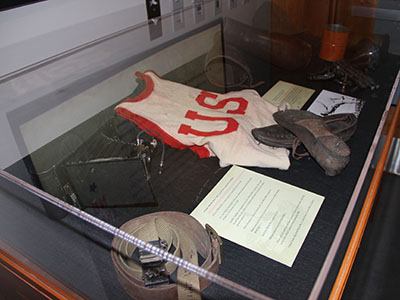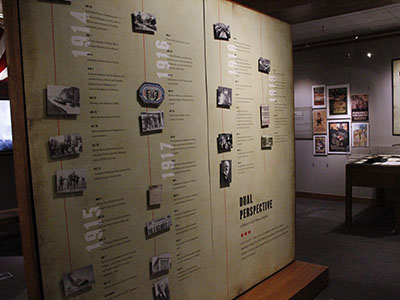New BYU Exhibit Chronicles World War I
Contributed By Jason Swensen, Church News staff writer
.jpg)
Perhaps the Church’s most prominent World War I veteran is Hugh B. Brown, an officer in the Canadian Army who would go on to serve in the First Presidency.
Article Highlights
- To commemorate the 100th anniversary of WWI, BYU has organized a visual exhibition called The Great War: A Centennial Remembrance.
- The exhibit is free of charge and will be on display until spring of 2015.
“I went into that hospital a proud British officer; I came out a humble Mormon elder.” —President Hugh B. Brown, officer in the Canadian Army and member of the First Presidency
Related Links
PROVO, UTAH
World War I—it’s been called “the Great War” and, ironically, “the War to End All Wars.”
It was also the first conflict that was so globally expansive that it could be aptly recognized as a “world war.” Occurring in an era of mass industrialization, World War I ushered in dramatic advances in military tactics and weaponry. And its cost in treasure and blood remains sobering 100 years later. It’s estimated that more than 16 million died in the war. Tens of millions more were injured.
Counted among the participants (and casualties) of World War I were, of course, many Latter-day Saints. To commemorate the 100th anniversary of World War I and Mormon involvement in the conflict, Brigham Young University has organized a highly visual exhibition display entitled The Great War: A Centennial Remembrance.
Located on the bottom floor of the school’s Harold B. Lee Library, the exhibition will appeal to seasoned historians, students, and campus visitors of all ages. The exhibition’s varied displays—all accompanied by narrative placards and cards—capture both the horrors of war and the spirit of sacrifice, faith, and patriotic duty that sustained its Latter-day Saint participants.
The items on display—including uniforms, journals, letters, weapons, war propaganda posters, and historical photos—were gleaned from the Church-owned school’s vast permanent collections.
A century has passed since the outbreak of the Great War. Names such as Wilson, Pershing, and Churchill remain prominent in today’s history textbooks. But the BYU exhibition reminds visitors that the war was about far more than national leaders and armies.
“Those armies were made up of common men who did uncommon things in a time of terrible violence,” reads the display panel at the entrance of the exhibit.
The exhibition is a visual history lesson on Latter-day Saint involvement in the war. Almost anyone can learn something here.

World War I marked the beginning of Latter-day Saints serving as chaplains during conflict. Elder B. H. Roberts, a General Authority, was among three Mormons who served as chaplains during the war. Photo by Jason Swensen.
.jpg)
A visitor to The Great War exhibit watches a video produced in conjunction with the exhibition. Photo by Jason Swensen.

Counted among the historical items in the exhibition are athletic wear from BYU student/athlete/soldier Clinton Larson. Photo by Jason Swensen.
Did you know, for example, that the Colt .45 Browning handgun used to assassinate Archduke Franz Ferdinand on June 28, 1914 (a crime that prompted the outbreak of the war) was a model designed by John Browning, a Mormon who was born in Ogden, Utah, in 1855?
Perhaps the Church’s most prominent World War I veteran was Hugh B. Brown, an officer in the Canadian Army who would later become an Apostle and member of the First Presidency.
The exhibition shares a faith-building moment from President Brown’s military service when he was summoned to a hospital that cared for wounded soldiers. He assumed a homesick serviceman would ask for his help in securing a discharge. Instead, he discovered a Mormon soldier who had been injured in battle and was earnestly seeking a priesthood blessing.
That experience forever changed the future Church leader.
“I went into that hospital a proud British officer; I came out a humble Mormon elder,” he wrote.
The Great War exhibit also introduces visitors to Thomas C. Neibaur, an American soldier and the first Latter-day Saint to receive the prestigious Medal of Honor after demonstrating great bravery while fighting a group of German soldiers despite being outmanned and outgunned.
Mormons also served as chaplains during World War I. Elder B. H. Roberts, who served as one of the Seven Presidents of the Seventy, was commissioned a U.S. Army chaplain despite being over 60 years old. While in uniform, Chaplain Roberts ministered to fellow soldiers in both life and death.
Among those he attended in passing was Stanford Hinckley, older brother of future Church President Gordon B. Hinckley.
The exhibition also recognizes BYU’s contributions during the war years. More than 460 students fought in the war. Sixteen were killed in combat.
Perhaps the most high-profile BYU student to wear the uniform was Clinton Larson, a school track star who would represent the United States in the Inter-Allied Games in Paris.
The Great War exhibition is free of charge and will be on display until the spring of 2015.

Included in the exhibition is a timeline where visitors can trace key moments in Church and World War I history. Photo by Jason Swensen.
